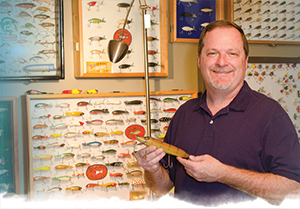MY EDMOND OUTLOOK: Ray Cromer
 What got you started on
What got you started on
collecting fishing lures?
I’m not really sure. I’ve always
been a collector, just never organized. I’ve always fished, and one time I
bought some old lures at a garage sale, did some research and found out people
collected them.
Are you an avid fisherman or do
you just prefer to collect?
I do both. I fish and I collect.
Where is your favorite place to
fish?
We have a cabin at Eufaula so I
go there quite a bit. But I’ve got a lot of favorite spots locally also.
Have you ever used any of your
vintage lures on a fishing expedition?
Yes I have. You don’t use the
ones that are in good shape. You take the ones that are beat up and have paint
missing. You can also take some of the older ones and recondition them to fish
with. It’s interesting to see if a 40- or 50-year-old lure actually works.
Which lure is your favorite?
Choosing a favorite is like
asking who is your favorite kid. However, I collect anything that was made in
Oklahoma.
How many lures do you own?
I’ve never counted them, so
there is no telling! But quite a few!
Do you just collect lures or do
you like all kinds of fishing equipment?
I also collect rods and reels,
but mostly lures. Lures are good because they are small and don’t take up a lot
of room. You can put a bunch of lures in a drawer.
What are some of the more
interesting pieces in your collection?
Some prototypes are interesting.
When companies first develop a lure, there’s an experimental version which I
like to collect.
What is Oklahoma’s history with
fishing lures?
Oklahoma has a good history,
especially after World War II. From the 1950s and on, there were quite a few
manufacturers around the state. My favorite Oklahoma manufacturer would be
Martin Lizard who was run by a man named Jack Martin out of Stillwater and
Drumwright. Also, an Oklahoma manufacturer known as Joe-Bob made crawdad lures
which are probably some of my favorites.
How do you go about collecting
the lures?
I visit old flea markets and
shop online. I also do trades with friends.
What is the value of a vintage
lure?
You can go to a lure show and
buy all kinds for about $2 a piece. Or you can spend hundreds of dollars on a
single lure—depends on your taste and how deep your pockets are.
How does a fishing lure work?
Some people think it’s the
color. Others think it’s the motion it makes when it goes through the water. I
think it’s the combination of the motion and vibration it has as well as the
color. The color is what collectors look for. A single lure may have 50
different colors and a collector will look for the same lure in all the
different colors. Some colors may be really rare and others really common—the
same lure may cost $2 in one color and $20 in another.
How have fishing lures changed
over the years?
They are still relatively the
same. They used to be made of wood prior to World War II, and then were
switched over to plastic. In fact, a lot of the ideas people come up with
aren’t really new—they are something somebody came up with a long time ago. They
all usually have a body with hooks and a diving lip. That’s why when you fish
with some of the old lures, they actually work. In the end, lures were made to
catch fishermen, not fish.
Have you ever stuck yourself
with a lure or hook?
Several times. It goes with the
territory. Got one stuck in my hand 3 or 4 times pretty deep. You have to make
sure your tetanus shots are up to date!




